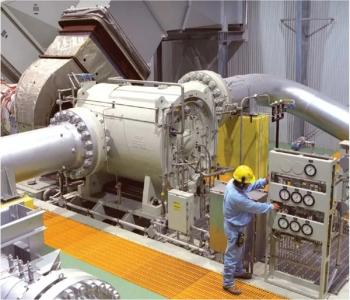
DOE-sponsored research helps improve gas turbine performance
An innovative airfoil manufacturing technology that promises to improve the performance of state-of-the-art gas turbines has been commercialized through research sponsored by the U.S. Department of Energy (DOE). The technology – which is expected to contribute to cleaner, more reliable and affordable domestic energy production as well as creating new high-tech manufacturing jobs – was licensed by Siemens Energy Inc. (Orlando, Fla.) in 2011. Siemens has now opened a new facility in Charlottesville, Va., employing Mikro Systems patented Tomo-Lithographic Molding (TOMOsm) manufacturing technology to manufacture improved airfoils.
DOE Small Business Innovation Research (SBIR) grants funded the essential research and development that advanced the capabilities of TOMO technology, as well as the work that led to the technology’s manufacturing readiness. The Office of Fossil Energy’s National Energy Technology Laboratory (NETL) managed the SBIR grants.
Gas turbines, which are used to produce power for industrial, utility and aerospace applications, consist sequentially of compressor, combustor and turbine sections. Incoming air is compressed to high pressure in the compressor section, and then heated to high temperature by the combustion of fuel in the combustor section. The high-temperature, high-pressure gas is then expanded through a series of rotor-mounted airfoils in the turbine section, converting the energy of the gas into mechanical work. Improved airfoils can tolerate higher gas temperatures and/or use less cooling air, resulting in improved energy efficiency.
Mikro Systems received DOE support to apply its TOMO technology to a range of turbine components, with the goal of improving the efficiency and performance of gas turbines used in stationary power generation. The technology enables more sophisticated designs with improved cooling characteristics, which leads to higher operating temperatures and improved efficiency. In addition to enabling designs that were previously impossible to manufacture, the technology promises to reduce time-to-market for future design enhancements through reduced production lead times and more efficient manufacturing processes.
Mikro Systems plans to apply the technology to a wide range of applications, from next-generation turbines for use in integrated gasification combined cycle (IGCC) and natural gas combined cycle power plants, to smaller industrial and military aviation engines. Rolls-Royce and the U.S. Department of Defense are now funding work by Mikro Systems. The technology is also contributing to Siemens Energy’s ARRA-funded, NETL-managed project to develop hydrogen turbines for coal-based IGCC power generation that will improve efficiency, reduce emissions, lower costs, and allow for carbon capture and storage.
Newsletter
Power your knowledge with the latest in turbine technology, engineering advances, and energy solutions—subscribe to Turbomachinery International today.





